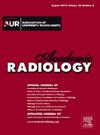Interpretable Deep-learning Model Based on Superb Microvascular Imaging for Noninvasive Diagnosis of Interstitial Fibrosis in Chronic Kidney Disease
IF 3.9
2区 医学
Q1 RADIOLOGY, NUCLEAR MEDICINE & MEDICAL IMAGING
引用次数: 0
Abstract
Rationale and Objectives
To develop an interpretable deep learning (XDL) model based on superb microvascular imaging (SMI) for the noninvasive diagnosis of the degree of interstitial fibrosis (IF) in chronic kidney disease (CKD).
Methods
We included CKD patients who underwent renal biopsy, two-dimensional ultrasound, and SMI examinations between May 2022 and October 2023. Based on the pathological IF score, they were divided into two groups: minimal-mild IF (≤25%) and moderate-severe IF (>25%). An XDL model based on the SMI while establishing an ultrasound radiomics model and a color doppler ultrasonography (CDUS) model as the control group. The utility of the proposed model was evaluated using the receiver operating characteristic curve (ROC) and decision curve analysis.
Results
In total, 365 CKD patients were included herein. In the validation group, AUCs of the ROC curves for the DL, ultrasound radiomics, and CDUS models were 0.854, 0.784, and 0.745, respectively. In the test group, AUCs of the ROC curve for the DL ultrasound radiomics, and CDUS models were 0.824, 0.792, and 0.752, respectively. The pie chart and heat map based on Shapley additive explanations (SHAP) provided substantial interpretability for the model.
Conclusion
Compared with the ultrasound radiomics and CDUS models, the DL model based on the SMI had higher accuracy in the noninvasive judgment of the degree of IF in CKD patients. Pie and heat maps based on Shapley can explain which image regions are helpful in diagnosing the degree of IF.
基于高超微血管成像的可解释深度学习模型在慢性肾脏疾病间质纤维化无创诊断中的应用。
基本原理和目的:开发基于高超微血管成像(SMI)的可解释深度学习(XDL)模型,用于慢性肾脏疾病(CKD)间质纤维化(IF)程度的无创诊断。方法:我们纳入了2022年5月至2023年10月期间接受肾脏活检、二维超声和SMI检查的CKD患者。根据病理IF评分分为两组:极轻-轻度IF(≤25%)和中重度IF(>25%)。建立基于SMI的XDL模型,同时建立超声放射组学模型和彩色多普勒超声(CDUS)模型作为对照组。采用受试者工作特征曲线(ROC)和决策曲线分析对模型的有效性进行评价。结果:共纳入365例CKD患者。验证组DL、超声放射组学、CDUS模型的ROC曲线auc分别为0.854、0.784、0.745。试验组DL超声放射组学模型和cdu模型的ROC曲线auc分别为0.824、0.792和0.752。基于Shapley加性解释(SHAP)的饼图和热图为模型提供了充分的可解释性。结论:与超声放射组学和CDUS模型相比,基于SMI的DL模型在无创判断CKD患者IF程度方面具有更高的准确性。基于Shapley的饼图和热图可以解释哪些图像区域有助于诊断IF的程度。
本文章由计算机程序翻译,如有差异,请以英文原文为准。
求助全文
约1分钟内获得全文
求助全文
来源期刊

Academic Radiology
医学-核医学
CiteScore
7.60
自引率
10.40%
发文量
432
审稿时长
18 days
期刊介绍:
Academic Radiology publishes original reports of clinical and laboratory investigations in diagnostic imaging, the diagnostic use of radioactive isotopes, computed tomography, positron emission tomography, magnetic resonance imaging, ultrasound, digital subtraction angiography, image-guided interventions and related techniques. It also includes brief technical reports describing original observations, techniques, and instrumental developments; state-of-the-art reports on clinical issues, new technology and other topics of current medical importance; meta-analyses; scientific studies and opinions on radiologic education; and letters to the Editor.
 求助内容:
求助内容: 应助结果提醒方式:
应助结果提醒方式:


